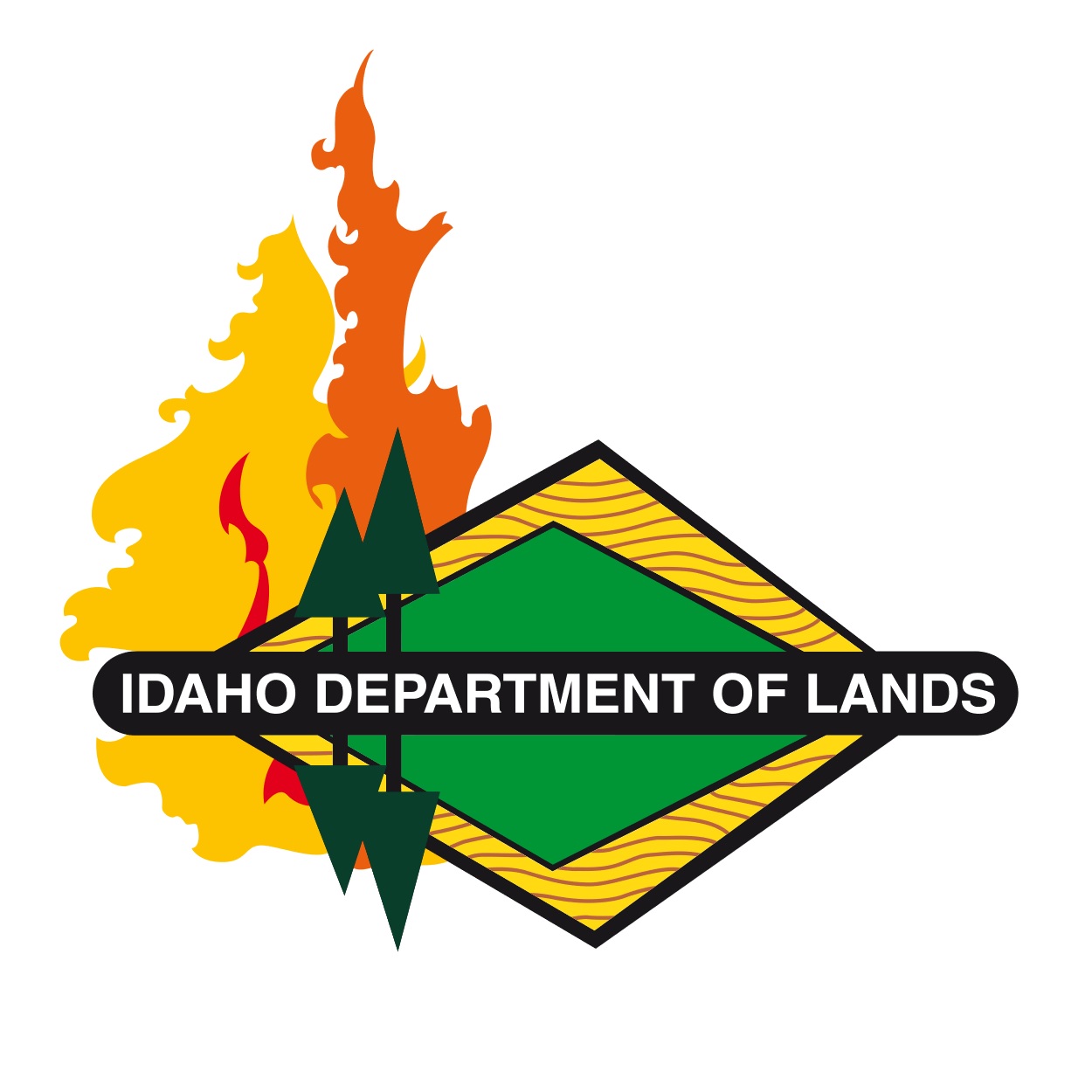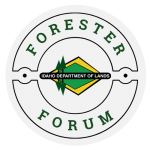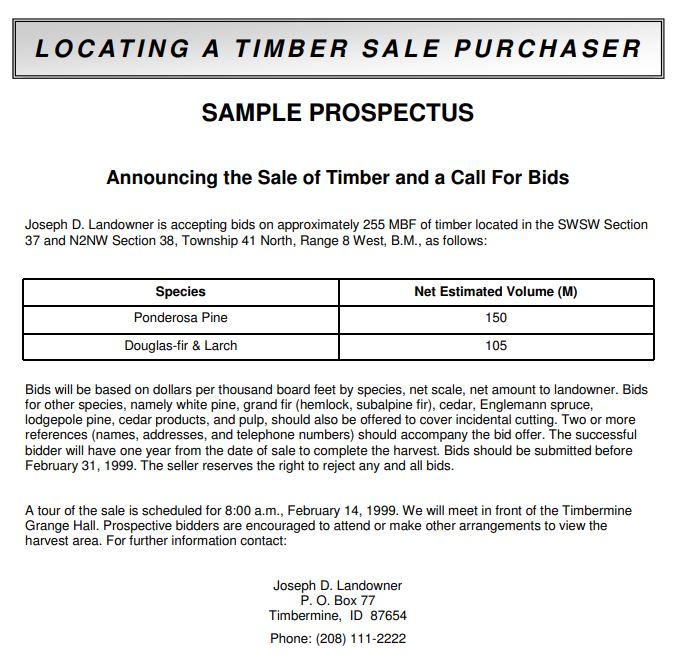Author: sphillips
Urban Timber: Capitalizing on a Tree-mendous Resource
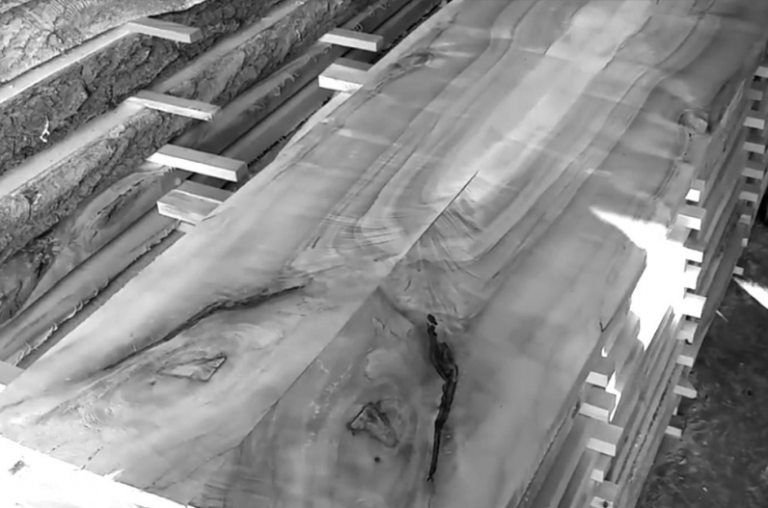
A lot has been written in this newsletter about trees in our communities when alive. But these trees can have a second life once they are removed—as a dinner table, artisan bowl, or other special creation. Unfortunately, most trees removed in our communities instead end up in landfills or, at best, are chipped or sold as firewood. The U.S. Forest Service estimates that enough urban wood is generated each year that, if sawn into boards, would produce 3.8 billion board feet of lumber, or nearly 30% of the annual U.S. hardwood production.
When Steve Cashman, a transplant to Star from the Midwest and a hobby woodworker, looked for hardwood lumber in southwestern Idaho last year, he found it a lot more expensive because it came from so far away. At the same time, he observed hardwood trees of the species he was seeking being removed in the cities around him.
Being cheap, as he told me, he started calling and e-mailing tree services, mills, and others to see how he could find and buy this local wood, but with no luck. By the time he contacted me last December, his original intent had transitioned into something much bolder. “I see a great resource being wasted,” Steve explained. “Why pay a lot of money to import hardwood when we have it right here? We have a valuable resource that can be grown, harvested, processed and crafted locally, becoming beautiful and functional products. Plus, carbon is stored long-term, new jobs are created and landfill space is freed up. The end product also has a backstory; the wood that panels a corporate office could come from the trees removed during construction, or a coffee table might be built from a tree planted by the owner’s great-grandparents, or from one that grew down the street.” After I talked with Steve, made some connections and provided some resources, Steve started that “big log” rolling.
The path hasn’t been easy. Steve owns a small data protection consulting business, so none of this is within his wheelhouse. He spent hundreds of hours learning about the entire process, including cutting, transporting, milling, throughout the Treasure Valley, but has so far found only one willing to help out. “Joshua Chavco (Chavco Tree and Landscape) has been great to work with,” Steve told me. “He understands and supports what we’re trying to accomplish and calls whenever he has a tree he’s removing that has potential.” As well, Boise City Forestry sells logs to the public from trees they’ve removed, so this has been another source. Another key partner is Mark Tucker (Tuckers Timber). He’ll drop off a trailer at the removal site so the logs can be loaded onto to it. He takes the logs back to his small mill and cuts them into slabs or boards. Steve then takes the boards home to air dry, store and sell.
So far, this nascent enterprise has produced about 1,000 board feet of beautiful live-edge slabs, boards and incredible burls for turning. Species include ash, walnut, gingko, maple, black locust, basswood and elm. As a woodworker myself, the photos on Steve’s Facebook page (www.facebook.com/208UrbanTimber) make my mouth water. It’s fantastic material.
I asked Steve what he hoped to accomplish over the next year. He told me, “I really want to grow the network – arborists, local artisans, architects, homebuilders and more – and demonstrably increase the supply of available wood. I’m not doing this to make money (eventually he plans to create a non-profit). I’m selling the wood at a price that covers costs with some to reinvest into improving the system so that prices can be kept low.”
As well, he would love for more tree services and cities to become partners. He added, “I know it takes less time to just chunk the trees up and take them to the landfill, but I hope the idea of reducing waste and atmospheric carbon, adding value and saving money in landfill fees will entice folks to be part of this effort. Steve welcomes feedback on how he can make the process as easy as possible for them.
If you’d like to be involved in any step of the process, from sourcing trees to buying the lumber, please contact Steve via his Facebook page.
Farewell to an Idaho Tree Man, Mike Bowman
By David Stephenson
Community Forestry Coordinator
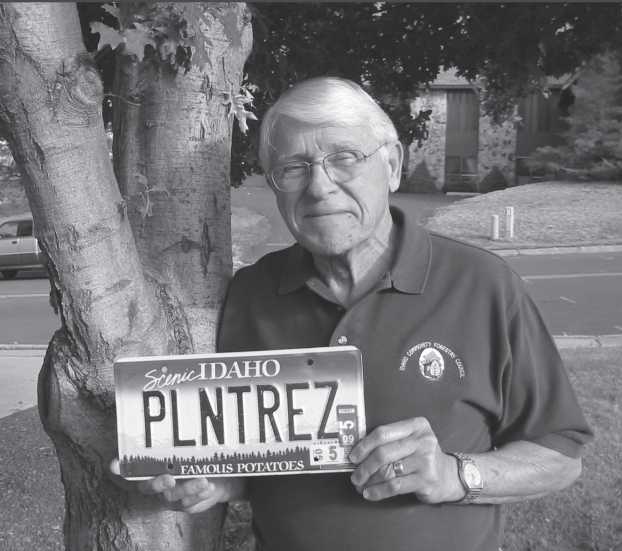
Idaho has lost one of the true champions of trees and urban forestry. Mike Bowman passed away at home on January 23, 2017.
I expect some readers may not have known Mike. By way of introduction, Jim Fazio—editor for the Arbor Day Foundation and this newsletter and a good friend of Mike’s—describes him well. “Mike Bowman was one of the most unusual men I’ve ever met. During forestry school he began his career as a smokejumper. He then went through the ranks of management in the Forest Service and BLM from Alaska and Idaho to Washington, DC. He had a new—and true—story to tell every time I was with him! After he ‘retired,’ he became Lewiston’s first urban forester and served on the Idaho Community Forestry Advisory Council for many years. After that, he served his church and the underprivileged in Moscow almost on a full time basis. He was a true Christian and humble hero.”
Most of us recall those key individuals that have made an impact in our lives and in our careers. Mike was one of those for me. I first met him when I moved to Idaho in 2002. As a member of the council that advised the IDL on the program I was hired to manage, Mike was both a mentor and advocate. What I remember most was his desire to innovate, to engage people, and to push us to step out of our comfort zones or, as Mike so often put it, “to think outside the nine dots.” As an urban forester, Mike was well known for his ability to form partnerships that turned otherwise impossible tree-related projects into reality.
When Mike started his second career as Lewiston’s City Forester in 1991, Idaho’s urban forestry program was just beginning. The list of his accomplishments over the next 15 years is exemplary. Just some of the many projects completed during his tenure were the city’s first tree inventory, a licensing program for arborists working within the city, a shaded parking lots program, a crabapple demonstration grove, a Lewis and Clark Memorial Grove, and public education programs that involved schools and service clubs. Beyond Lewiston, Mike helped a host of other communities create and grow their community forestry efforts, and he was a key voice in shaping IDL’s program.
The programs and efforts he helped foster, the thousands of trees he planted, and the people he encouraged and helped are his legacy.
Forest Management 3: Timber Sale Contracts
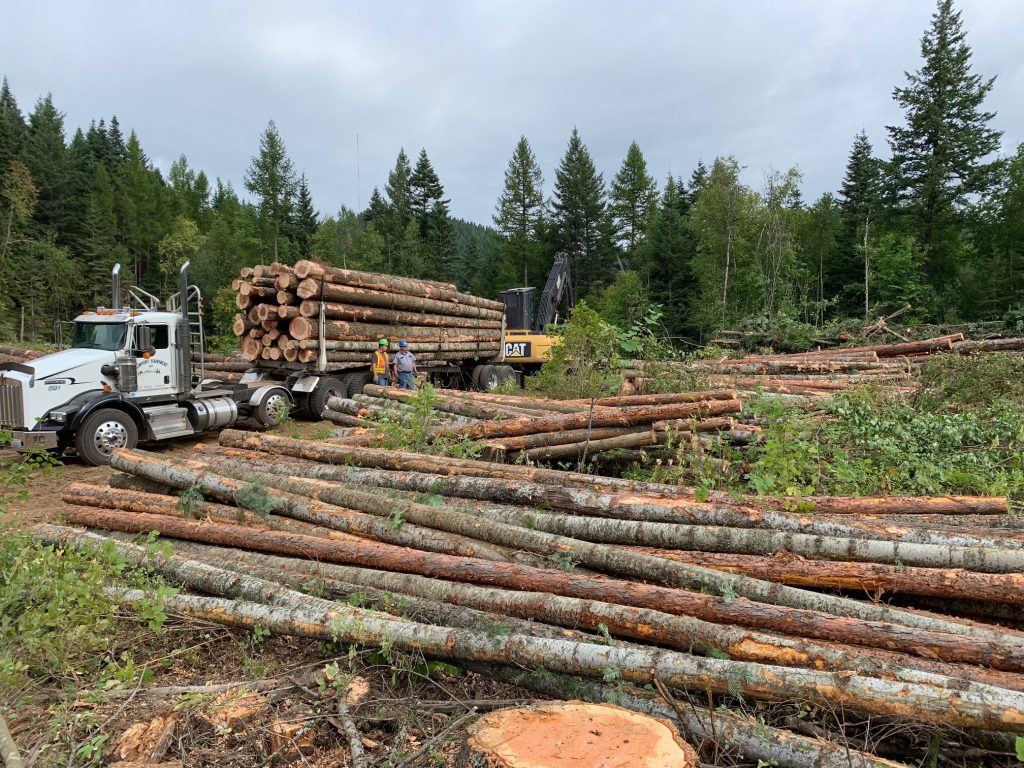
In this edition of the Forester Forum
Overview
Too often timber harvests are conducted with no more than a nod and a handshake between the parties involved. Although this procedure sometimes works, a written agreement is far better. Besides transacting the sale of timber, a contract also establishes communication, outlines practices to be followed, and clarifies responsibilities. All participants benefit when a foundation is established from the start.
At first glance, preparing a contract might appear difficult, inconvenient, and downright formal. However, with a little help, writing a good sales agreement can be done with ease and satisfaction.
Sample Contracts
Since there is no such thing as a standard, concise, all purpose timber sale agreement, it’s good to start with a handful of examples. A variety of sample contracts can be acquired from your local Idaho Department of Lands office, timber company, soil conservation district, or extension agency. These generic contracts are often used as a basis for building a specific agreement and with them you can create a document tailor-made to fit your harvest situation.
The Document
Let’s look at the substance of a good timber sale contract. Most importantly, it is as short and simple as possible, with clear wording in plain language. The terms are understandable, executable and enforceable. Although such an agreement will not cover every eventuality, it will set some important guidelines.
A checklist is provided below, which highlights appropriate information needed in a complete document.
Framing a Contract
Good sample contracts will address most major issues. Combine the best terms from several samples. Also, see your IDL Private Forestry Specialist for help. Although the PFS cannot write the contract, they can equip you with a menu of terms covering harvest practices and recommend clauses you should consider.
With all this information, you can mix, match, add, delete, or write your own terms of sale. Be careful, more restrictions usually result in higher logging costs. Just include enough requirements to accomplish your objectives and protect your interest.
Have a forester and a lawyer review your draft.
There is safety in an abundance of counselors.
Administration
Finally, consider this. Your contract is a tool that protects your interests, conveys your desires, details procedures, and assigns responsibilities. But a successful timber harvest does NOT depend only on a well written document. It depends on communication and implementation. A contract not administered is a tool not used. Keep watch over your harvest operations. Administer your contract to achieve your goals.
Contract Checklist
For the purpose of this article, it is assumed the landowner is the timber owner.
Parties Involved
- Names and addresses of both landowner seller) and logger (buyer, purchaser, operator, contractor)
- Signatures of seller, buyer, and witnesses
- Date of agreement and place of execution
- Notarization of the contract
Performance of Buyer
- Duration of contract with or without a provision for extension or assignment
- Cash or surety bond posted by the buyer to ensure full and faithful compliance with all contractual obligations
- Clause to terminate operations due to noncompliance
- Liability and Workers’ Compensation Insurance requirement
- Clause for arbitration of disputed contract execution by buyer or seller
- Force Majeure” clause for release of obligations by buyer or seller due to fire, flood, strike, or other catastrophe
Payment
- Terms of payment (how, when, and to whom)
- Scaling (if applicable, including the scale to be used, who will scale, when) where, and
- Penalty for cutting undesignated timber
Property Involved
- Complete legal description of the harvest area with a map to scale
- The party responsible for locating or establishing property corners, lines, and harvest area boundaries
- Timber being sold (identified by species, products, estimated volumes, unit of measure, net or gross scale price per unit, cutting designations of tree marking)
- Ownership of timber and when title passes from seller to buyer
Harvest Practices
- Compliance to the Idaho Forest Practices Act
- Compliance to the State slash hazard (disposal) and fire protection laws who piles, burns, reduces, and pays the State
- Size and types of logging equipment
- Utilization guidelines (maximum stump height, log size, merchantable tree and log standards, and minimum top diameter
- Location and standards of roads, landings, and skid trails
- Protection of fences, gates, roads, livestock, structures, and post-logging “touch-up” of roads, trails and culverts
- Clean-up of garbage and waste
- Party responsible for acquiring and maintaining access and right-of-way
Questions? Find an IDL Private Forestry Specialist
Help is Only a Click Away
Forest Management 2: Planning a Timber Harvest
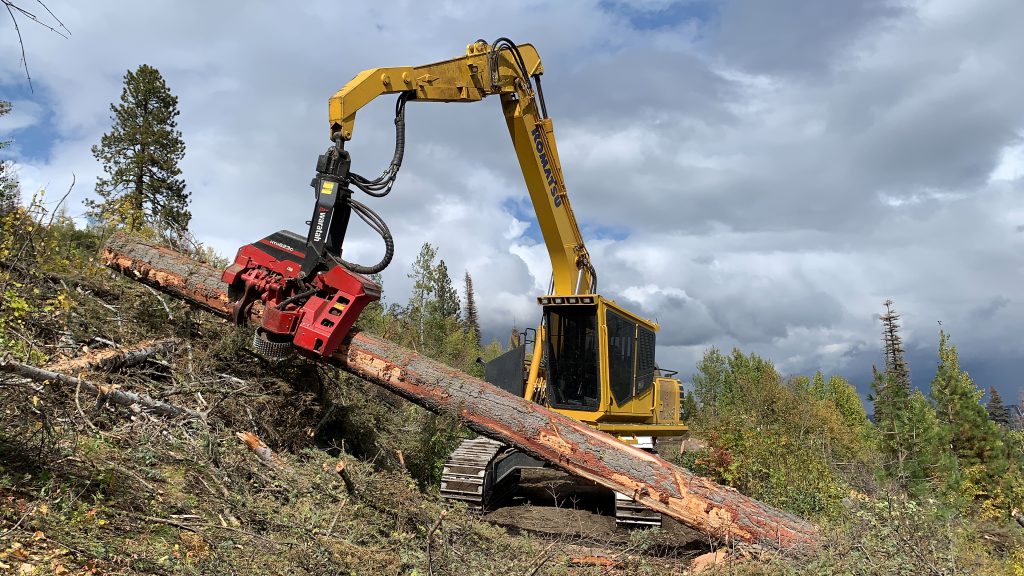
Planning a Timber Harvest
In this edition of the Forester Forum
Overview
Informed family forest landowners know you can harvest trees, make a profit and still have a healthy thriving woodlot that looks good. Sound impossible? Well, the truth is a forest can be improved with a successful timber harvest. Planning is the key and good planning depends on making good decisions.
You don’t have to know everything about forestry to plan a successful harvest, but you do need to be informed. When preparing a timber harvest, answer the following questions.
What Do I Have?
The foundation for any plan is laid with this information. Determine the age, species composition, volume, value and health of your timber. Identify non-timber resources such as roads, streams, wildlife habitat, or scenic areas. Recognize land forms and soil types which require specialized logging systems or may preclude logging altogether. In other words, really get to know your woodlot.
What Does My Woodlot Need?
Determining what you have often answers this question. Silvicultural prescriptions should be designed to benefit the existing stand’s health or regenerate a new forest.
Learn to recognize insect and disease problems and the need for salvage work, thinning or planting. Identify transportation and access needs such as road repair, culvert installation, erosion control and additional road construction. Consider how to protect streams, wildlife and scenic areas. Plan logging that will improve your woodlot, not merely remove timber.
What Do I Want?
Blend your economic and long term management dreams with reality. Understand what you are trying to accomplish and weigh the costs and ramifications of doing it. Set goals. Know what you want and be able to explain it. Make your logger see your vision and maintain constant communications with him. Plan to write a timber harvest contract that will communicate and protect your desires.
Do I Need Professional Input?
YES! To do things right you need a botanist, economist, timber cruiser, entomologist, pathologist, engineer, hydrologist, ecologist, wildlife specialist and landscape architect. But in a pinch, a forester will do!
Foresters with the Idaho Department of Lands offer services without charge. Although their time and services are limited, it’s a good idea to start with these people. They can highlight problems, potentials, and values, write management plans and help locate a logger or consultant. For a fee, private consulting foresters can do much more, such as surveying, cruising, marketing, administer the job, and more. Industry foresters and logging contractors sometimes have woodlot programs or offer advice. Remember, there is safety in an abundance of counselors.
Good planning is an essential part of a successful harvest. In fact, planning is more than half the job. Invest the time and resources necessary to make good decisions about your woodlot.
Questions? Find an IDL Private Forestry Specialist
Help is Only a Click Away
Forest Management 1: Idaho Timber Facts
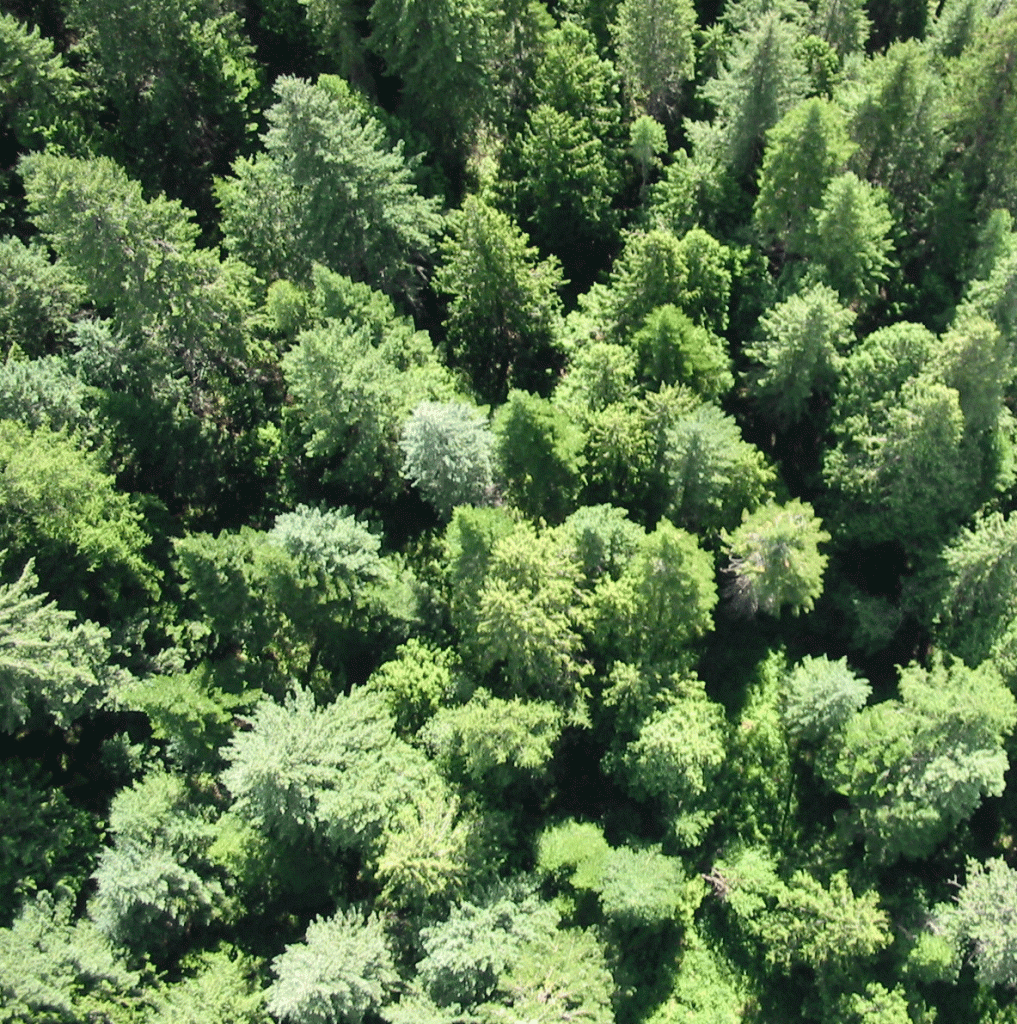
Idaho Timber Facts
In this edition of the Forester Forum
10 Year Harvest Summary
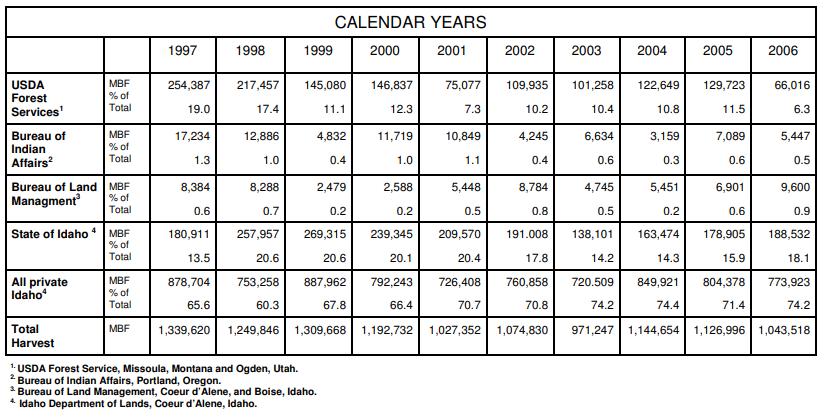
Private Timber Harvest by County
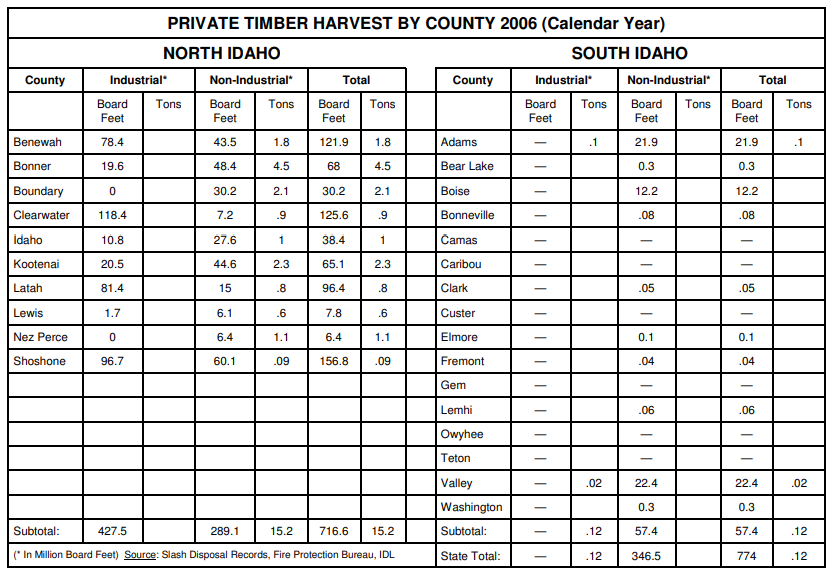
Facts About Idaho's Timber Industry - 2003
- 33 of Idaho’s 44 counties have at least one primary wood product manufacturing plant.
- The forest products industry employed some 18,052 workers in 2003 with an average wage exceeding $31,000.00.
- 171 Active Wood Products including:
- 178 sawmills
- 24 plywood and veneer plants
- 1 waferboard plant
- 71 utility pole, house log, cedar products, post and small pole plants
- 1 paper mill
- 3 residue-utilizing plants
- In 2003, Idaho had about 8 percent of the nation’s softwood timber inventory, or an estimated 117.8 billion board feet Scibner.
2003 Primary Wood and Paper Production in Idaho
- 2.01 billion board feet lumber
- $1.69 billion dollars estimated wholesale value
- 4th Largest producer in Western U. S. (behind Oregon, California, Washington in that order)
- 16,000 Lumber and other wood products jobs.
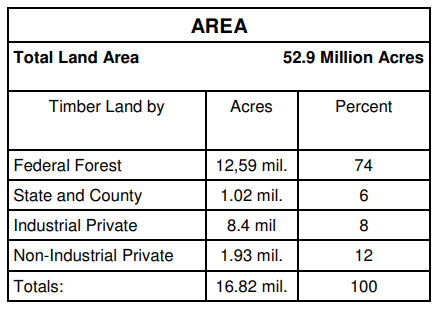
Forest Management 9: Snag Management
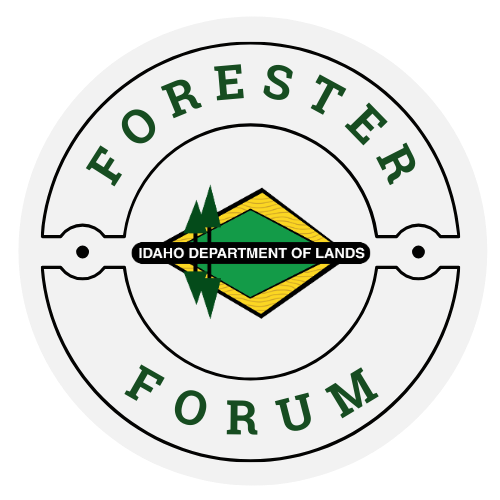
Snag Management
In this edition of the Forester Forum
Overview
A snag is a standing dead or dying tree. It may have died because of wildfire, insects, disease, lightning, or a combination of factors. Regardless of the reason for its death, a snag can be very important to many kinds of wildlife.
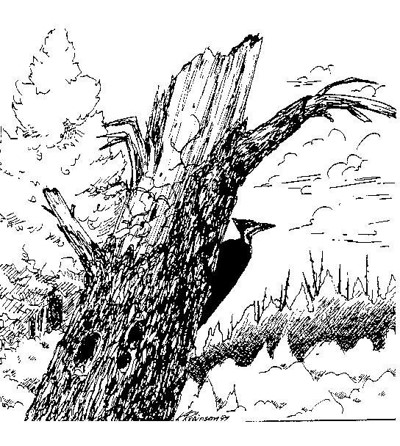
Why Are Snags Important?
Snags provide food and shelter for many creatures. Woodpeckers hunt for insects and nest in snags. Bats hibernate under the thick, loose bark of large snags. Insects reside within the dead wood and help speed up the process of decay and nutrient recycling. Wood ducks and bluebirds nest in cavities created by previous residents. Snags provide convenient perches for hunting hawks and owls. Bald eagles often use large cottonwood snags or dead topped trees near lakes or rivers for perching, nesting and roosting.
For many kinds of wildlife, snags are a critical habitat component. Nothing can replace snags for these species. For example, some woodpeckers excavate new nest and roost holes every year. These birds are known as primary cavity nesters. Other cavity nesting birds and animals use old, vacated cavities. They are known as secondary cavity nesters. Bats, bluebirds, pine martens and owls are examples of secondary cavity nesters. Nest boxes can provide cavity habitat for secondary cavity nesters if snags aren’t available but suitable snags are essential for primary cavity nesters.
Snags are important to people in both direct and indirect ways. Many homes are heated by wood burning stoves. Woodpeckers, bats and other insectivorous (insect-eating) creatures are very beneficial to landowners because they can help prevent damaging insect outbreaks or help control insect epidemics in the early stages. Many people enjoy watching woodpeckers, bluebirds and other wildlife that inhabit snags.
Which Snags are Best?
From a wildlife point of view, some trees are more suitable for snags than others. Each snag dependant species has its own unique criteria for determining which snag it uses. Tree species, height, diameter, the stage of decay, the distribution of other snags in the area (clumped or scattered), and the successional stage of the plant community where the snag occurs (such as a field, a young forest or an old growth stand) are all important factors.
Generally speaking, hardwoods like birch, aspen, and cottonwood and softwoods like western larch, ponderosa pine, and western redcedar are the most valuable tree species for cavity nesters. Other tree species that can make suitable snags include, in order of preference, Douglas fir, grand fir, western hemlock, lodgepole pine, spruce, subalpine fir and western white pine. The order of preference varies somewhat, depending on the species of wildlife. For example, yellow-bellied sapsuckers live in aspen/birch and riparian/cottonwood communities. White-headed and Williamson’s woodpeckers nest and feed in ponderosa pine and mixed conifer forests. Blackbacked three toed woodpeckers are found in lodgepole pine and subalpine fir communities. Each of these kinds of birds prefer different types, sizes and numbers of snags.
Snag size is an important factor. The basic rule of thumb is “the bigger, the better”. To be valuable for most cavity nesters, snags must be at least 10 inches in diameter and 20 feet tall. Pileated woodpeckers require a snag at least 20 inches in diameter for nesting.
There are two types of snags, soft and hard. A hard snag is composed mostly of sound wood, especially on the outside. The top is usually intact and many dead branches remain. Soft snags are snags which are in the advanced stages of decay. Soft snags usually have broken tops and few limbs. Hard snags eventually become soft snags. Some tree species tend to become hard snags much more readily than others, due to their decay characteristics. Both soft and hard snags have habitat value for cavity dependent wildlife because soft snags are preferred by some species and hard snags are more important to other species.
How Can I Provide Snags on My Forest Land?
There are a number of ways to provide an adequate and continuous supply of snags for the cavity dependant wildlife in your area.
- Leave all existing snags and dying trees standing, especially those showing obvious signs of use by wildlife. Trees with root rot should not be used unless absolutely necessary, since they are unlikely to remain standing for very long. If a snag poses a safety hazard, remove it, but leave a substitute elsewhere.
- Identify and mark live trees that would make good snags in the future. These “recruitment trees” can be defective or cull trees, preferably occurring in clumps. Trees with dead or broken tops are especially good. Again, leave all trees with obvious signs of wildlife use. Designate at least two live trees for each future snag desired.
- Tall stumps may be used by wildlife in some instances, especially when they are large diameter. Leave tall stumps standing.
If necessary, snags can be created by girdling or topping (by blasting or sawing) live trees. Topping is usually the best choice because a topped tree will tend to remain standing longer than a girdled tree. Also, topping leaves a live tree that can still increase in diameter. - Nest boxes can be put up for secondary cavity users if suitable snags are not available. Keep in mind that if the needs of primary cavity nesters are being met, the needs of secondary nesters are usually being met, too.
How Many Snags Should I Leave?
Although there is no hard and fast answer, cavity dependant wildlife must have enough snags in their habitat for their populations to survive over time. Also, the more snags of various sizes that can be provided across a variety of community types, the larger and more diverse will be the populations of cavity users.
Deciding how many snags to leave depends on the specific site, the wildlife species under consideration and the wildlife population level desired (i.e. the desired percentage of an average population that the area will support). For example, the number of snags needed to maintain wildlife population levels at various percentages of normal in a mixed conifer community type are as follows:
Snag and Wood Debris Management Guidelines
| 100 % Level | 60% Level | 40% Level | |
| Number of Snags Needed per 100 Acres | 14 > 20″ | 8 > 20″ | 6 > 20″ |
| 136 > 12″ | 82 > 12″ | 55 > 12″ | |
| 75 > 10″ | 45 > 10″ | 30 > 10″ | |
| Totals | 225/100 AC | 135/100 AC | 90/100 AC |
| From IPNF Snag and Wood Debris Management Guidelines | |||
Other important considerations include the quality of cavity habitat available elsewhere in the area, the logging system used for timber harvest, the type of site preparation, and other factors. Snags less than 10 inches in diameter should be left if possible, but should not be counted as part of the total number of snags per acre. Large snags can be substituted for small ones to meet wildlife needs, but never vice versa.
By leaving snags you help maintain a wildlife legacy for future generations to enjoy.
Forest Management 7: Tree Planting

Tree Planting
In this edition of the Forester Forum
Overview
The key to a successful planting program is to provide a micro-environment that fosters the survival and subsequent growth of the planted seedlings. While young seedlings are tough, excessive handling or dropping of the seedling can cause damage and stress, reducing survival and growth.
Follow these important steps to achieve a successful planting.
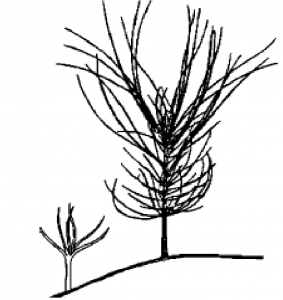
Seedling Storage
Seedlings should be stored at 33° to 35° Fwith high humidity. Seedlings can be stored in the refrigerator for a short period of time by enclosing them in a plastic bag.
If your seedlings have been stored in a cooler at 33° to 35° F, they will need to be “acclimatized” to the site they are to be planted in. Seedlings should be stored onsite (in the shade) one day before planting.
Soil Temperature
Ensure that soil temperatures are warm enough to promote rapid root growth.
Use a thermometer and place the recording end about four inches deep into the soil. Springtime soil temperatures should be a minimum of 40° F for several days before seedlings are planted. This is to ensure good root egress and to establish a “water chain” between the soil and the seedling, and to anchor the seedling in the ground.
Roots do not grow at cooler temperatures and seedlings can dry out during windy days due to seedling roots being unable to extract enough moisture for transpiration.
Sun and Wind Protection
3Protect your unplanted seedling from direct sunlight, wind, and high daytime temperatures. Store seedlings in heavy shade on north aspects or under suspended tarps three to four feet above the seedling boxes so as to provide adequate shade and good air movement
Keep unplanted seedlings cool!
Planting Locations
Wherever possible, plant seedlings on the north and east sides of stumps, logs, large rocks, and debris. These “microsites” will help protect newly planted seedlings from solar radiation and lethal daytime temperatures, wind, and animal traffic during the first few growing seasons.
Planting Holes
Avoid holes and depressions where dirt and water will collect and not drain off of the planting spot. Avoid areas where soil is mixed with excessive amounts of litter, slash, or other debris.
Dig a hole deep enough for the roots. Make sure that the roots are straight and do not bend (“J” or “L” roots). Spades, shovels, and mattocks work best. Take only one seedling out of the bundle at a time. This protects the other seedlings from drying out.
Questions? Find an IDL Private Forestry Specialist
Help is Only a Click Away
Forest Management 6: Consulting Foresters

Consulting Foresters
In this edition of the Forester Forum
Overview
You can see professionals in every line of work. Forestry is no exception.
A consulting forester knows the technical aspects of forestry, including the inner workings of the marketplace for wood products. They are experienced and skilled and are recognized as experts in their field. Professional consulting foresters blend the art and science of managing forest ecosystems. Their business is providing forestry expertise to your needs.
What is a Consulting Forester?
Educated: Generally, consulting foresters are well educated, hold a bachelor of science degree or higher in forestry or some closely related field. They are versed in silviculture, botany, soils, economics, forest engineering, hydrology, ecology, forest insects and diseases, marketing and other disciplines.
Experienced: Consultants have usually gained diverse experience in your area. They are knowledgeable about local markets, tree species, geology, contractors, laws, and practices.
Competent and Professional: Years of education and experience make consultants good people to approach with your forestry needs. Like any professional, their goal is to serve you.
What Can a Consulting Forester Do?
Consultants are knowledgeable about their special aspects of forestry. Typical services include: developing management plans, conducting timber inventories, appraising land, planning harvests, marking trees, writing contracts, marketing wood products, and administering forest management projects such as logging, thinning, or planting.
Utilizing a consultant often has hidden advantages for the landowner. Greater revenues are realized; better forestry is applied; fewer or no headaches are encountered; and a forest with a future is left standing for the landowner to use and enjoy. In addition to timber management goals, consulting foresters can also help you realize goals for wildlife, clean water and aesthetics.
If you are a woodlot owner, consulting foresters benefit you.
What to Look for in a Consultant
Ethics: True consultants regard ethics as the foundation of their business. They are quick to point out the following standards. Look for these attributes when hiring a consultant:
- Their services are available to the general public.
- They represent their client, solely.
- They harbor no undisclosed interests that would conflict with the interests of their clients.
- They comply with all local, state, and federal laws and requirements.
References: Consultants are proud to offer references. They will emphasize work they have accomplished in the past and share their track record on forest practice compliance with IDL. Also, check for educational credentials and ties to professional forestry associations, such as the Association of Consulting Foresters (ACF) and the Society of American Foresters (SAF).
Management Alternatives: Hire a forester who can offer several management alternatives. These ideas should revolve around your land management objectives.
Accounting: Look for someone with an accounting procedure that does a good job of documenting revenues and expenses.
How Are Consultants Paid?
Payments for services rendered can vary greatly, depending on the job being done. Usually, the first consultation is free. This gives the landowner and forester a chance to get acquainted. If a timber harvest is conducted, the consultant’s fee may be charged as a percentage of the sale revenue. Sometimes, the consultant is paid a set price per unit volume harvested (i.e., X amount of dollars per thousand board feet). Flat rate payments for services are also common, especially when no timber is harvested.
It is important to check with several consultants. Shop around for the services and value that will best meet your needs. Many consultants will tailor their programs to fit you and your management goals. Remember, the consulting forester works for you! Meeting your needs should be his top priority.
Finding a Consultant
Consultants often advertise in trade journals or the yellow pages of your telephone directory. Idaho Department of Lands Private Forestry Specialists can also make referrals. Contact your local IDL office for further information about forestry consultants.
Questions? Find an IDL Private Forestry Specialist
Help is Only a Click Away
Forest Management 5: Administering a Timber Harvest

Administering a Timber Harvest
In this edition of the Forester Forum
Overview
In technical terms, timber sale administration is the supervision of harvest activities to achieve silvicultural and economic objectives through sound logging practices and proper log utilization. In plain English, sale administration is telling a logger what you want before it’s too late.
Communication and cooperation between a landowner and the logger is crucial. Very often, operators receive no feedback from landowners until a problem arises or the harvest is completed. But loggers need constructive input and criticism all during a harvest so they can adjust to the landowner’s desires.
Here are some items to monitor while a harvest is in progress.
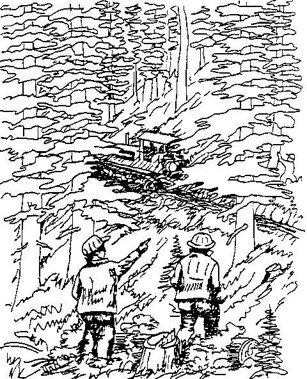
Falling Operations
Make sure only designated timber is being harvested. Trees marked reserve or protected by a diameter limit should be found standing and in good condition when
the dust clears. If overcutting is evident, let operators know immediately so they can adjust. Once in a while, it is impossible to avoid cutting or damaging a reserve tree. Be tolerant of an occasional glitch.
Also, determine if enough is being cut. Over the course of a harvest, thousands of board feet can be left in the woods in the form of small merchantable trees or unreasonably high stumps.
Skidding Operations
Although the right trees are cut, they may not leave the woods. Occasionally a small merchantable tree, log, or chunk is missed or purposely forgotten. Mark any missed piece with flagging or paint. Let operators know they are expected to retrieve missed logs.
Loading Operations
Falling, skidding, and decking a tree does not insure it will get to the mill. Check landing debris and slash piles for merchantable logs and pieces. Mark them for retrieval.
Log Quality
Any merchantability and utilization standards outlined in the contract should be consistently met. Examine manufactured logs at the landings. Determine if they are being cut to the required top diameter. Also check the necessity of long butting. Logs do not usually have to be totally free of rot to be merchantable. Contract standards should be met.
Forest Practices Requirements
Anyone conducting a timber harvest needs to be familiar with the rules and regulations of the Idaho Forest Practices Act (FPA). Copies can be obtained from your local IDL Private Forestry Specialist (PFS).Most of the rules protect water quality and land productivity.
Normally, random inspections are conducted by IDL, but a Private Forestry Specialist will also visit upon request. The Private Forestry Specialist can answer questions, provide assistance, or conduct a joint inspection. Forest Practice Act rules should be incorporated into the sale contract and enforced.
Slash Disposal
Slash piles need to be relatively free of dirt and in a burnable condition. Have piles located a safe and required distance from green trees, streams, or ponds. If the adequacy of slash disposal is in question, contact your local fire warden or Private Forestry Specialist for an inspection or advice.
Development and Other Items
The quality, progress, and completion of development work such as culvert installation, road construction, surfacing, etc. should be checked against the technical specifications of the contract. Also, monitor the protection of fences, gates, ponds, roads, and other land improvements. Make sure garbage, filters, cans, etc. are cleaned up and properly disposed.
What About Conflicts?
A conflict can arise even with open communications and active administration. Questions and concerns should be taken to the sale purchaser or whoever is responsible for
operations. It’s advisable to resolve any conflict as soon as possible. If an impasse is met, the contract should include provisions to halt operations and arbitrate disputes. Such action can put a damper on cooperation and should only be used as a last resort.
No harvest can be firmly administered without a well written contract. That document serves as the authority on practices, responsibilities, and procedures. A contract enhances sale administration but does not complete it. Administration is looking after a harvest while maintaining open and active communication and cooperation. Administer your harvest to achieve your goals.
Questions? Find an IDL Private Forestry Specialist
Help is Only a Click Away
Forest Management 4: Locating a Timber Sale Purchaser

Locating a Timber Sale Purchaser
In this edition of the Forester Forum
Overview
Experienced landowners know that a successful timber harvest requires planning. After management objectives, silvicultural prescriptions, and contractual requirements are formulated, a purchaser must be found. Usually, timber sale purchasers are responsible for logging operations. They can make you satisfied or disappointed in the results.
There are plenty of competent purchasers in the market. Consulting foresters, logging contractors, log brokers, and saw mills all vie for stumpage. Names and addresses of local timber buyers can be obtained from your local IDL office, extension agent, or telephone directory. Once potential purchasers are known, the following procedures may be helpful in selecting a purchaser.
Write a Prospectus
A prospectus is a notice of request for bids with a brief description of the planned harvest. It usually lists the species, volumes, and products being sold, a legal description of the harvest area, a tentative sale date, the seller’s name and address, and any other pertinent information. Explain the exact form and details wanted for the bid price.
Harvest Area Tours
Interested purchasers need an opportunity to examine the timber, understand the harvest objectives, review the sale contract, and estimate their logging costs. This can be accomplished with a tour of the harvest area. Arrange group or individual meetings, which ever is more convenient.
The most important aspect of the tour is communication. Purchasers need to understand the seller’s goals, requirements, and desires so they can offer competitive bids. Likewise, sellers have an opportunity to glean information about logging and log markets. Comments or criticisms from seasoned woodsmen may be useful in revising the harvest plan.
Call for Bids
Customarily, bids are accepted two to four weeks after the prospectus is sent out. Depending on how the timber is being sold, bids are based on the price per unit volume (i.e. thousand board feet , cords, etc.), the price of the entire sale, or the costs of logging per unit volume. Loggers charge no fee for the “estimates” since they are trying to land a job. Always reserve the right to reject any or all bids.
Get References
Since the bidder of the highest amount to the landowner may not always be the best choice, have interested parties submit references with their bids. Investigate any likely candidate before awarding the contract. Choose contractors based on their track record as well as their price.
Once a purchaser is selected and the contracts are signed, maintain communication. The purchaser deserves seller input and constructive criticism so adjustments can be made. Responsible contractors want to do a good job. Administer your harvest with this attitude in mind.

